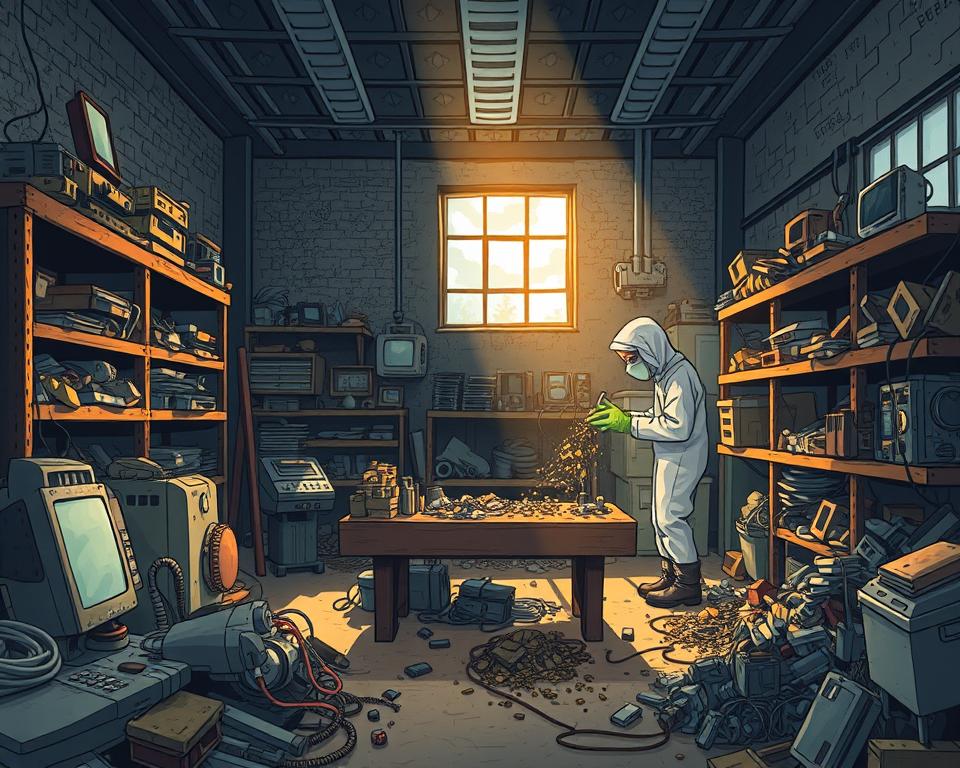Your Sustainable Precious Metal Recycling Guide
More than $60 billion in precious metals end up in e-waste every year—did you realize that? This staggering figure underlines the critical role of precious metal recycling. It’s not just good for our economy but also for the environment. When we recover gold, silver, platinum, and palladium, we reduce pollution and conserve resources.
Companies like Dongsheng Metal Trading are leading the charge towards sustainability. They guarantee that valuable metals return to use instead of filling dumps. This precious metals recycling companies approach is key to eco-friendly recycling and sustainable practices.
Key Takeaways
- Over $60 billion in precious metals is disposed of in electronic waste annually.
- Recycling precious metals shrinks environmental harm and saves resources.
- Gold, silver, platinum, and palladium top the list of valuable metals.
- Eco-friendly recycling practices are vital for sustainable development.
- Recycling experts like Dongsheng Metal Trading lead the industry.
Understanding Precious Metals and Their Value
Rare metallic elements known as precious metals attract both investors and manufacturers. Gold, silver, platinum, and palladium stand out for their distinct qualities. These include electrical conductivity, corrosion resistance, and substantial rarity. Given the resource-intensive mining and processing, recycling precious metals is essential.

Intrinsic qualities and demand in the marketplace determine precious metals’ worth. Recovering metals is key to keeping the supply chain alive. It cuts the environmental toll of mining operations. Advanced recycling can bring metals back to their initial quality. This preserves finite resources while yielding economic benefits.
Precious Metals Explained
Unique features make precious metals ideal for many uses. Their rarity and intrinsic properties are foundational to their economic significance. For example:
- Gold: Valued for its beauty and resistance to tarnish.
- Silver: Known for flexible uses and excellent conductivity.
- Platinum: Renowned for strength and catalytic uses.
- Pd: On the rise in automotive and tech industries.
Why Recycle Precious Metals?
Recycling these metals is now key to sustainable practices. It saves scarce materials and sharply cuts mining’s eco-footprint. Consider these advantages:
- Reduction of environmental degradation caused by mining operations.
- Lower energy consumption compared to extracting new metals from the earth.
- Supporting a circular economy via material reuse.
- Economic upside from extracting high-value resources.
Impact of Recycling Precious Metals
Recovering metals delivers big eco and financial wins. Highlighting these advantages is key to reducing our ecological footprint. Additionally, it fuels market growth and resilience.
Green Benefits
The environmental benefits of recycling precious metals are significant. Retrieving metals from scrap and electronics reduces landfill load. That cuts new mining needs and saves resources.
This approach minimizes the harmful effects of mining, such as habitat destruction and pollution. By prioritizing recycling, we work toward a greener tomorrow.
Economic Benefits
Economic upsides of recycling stand out equally. Using reclaimed metals trims manufacturing budgets. It lets businesses choose reclaimed over freshly mined metals.
It spawns jobs in recovery plants and steadies markets as recycled-metal demand rises. Using these financial benefits, companies can improve profits. They add to a more sustainable marketplace.
How Precious Metals are Recycled
Metal recycling demands a multi-stage process to optimize recovery. It starts with collecting metals from various sources like discarded electronics, jewelry, and industrial scraps. Next comes sorting, cleaning, and testing to assess metal content and worth.
The Precious Metal Recycling Process
Such a methodical process ensures efficient recovery. Every phase aims to maximize precious-metal returns. Sorting divides metals by kind and grade. Cleaning strips away impurities that impede extraction. Chemical analysis pinpoints metal levels to drive technique decisions.
Recycling Techniques Used
Cutting-edge processes boost precious-metal recovery. Thermal reduction, using high temperatures to separate metals from ores, is a key method. Molten refining and wet-chemistry steps handle finer separations. Firms such as Dongsheng Metal Trading apply these techniques to raise recovery and profits.
Types of Precious Metals that can be Recycled
Scrap recovery benefits both Earth and economy. Many precious metals can be recycled, benefiting both the economy and the planet. Awareness of recyclable metals guides consumers and companies.
Gold, Silver, and Platinum
Familiar precious metals include gold, silver, and platinum. They’re found in jewelry, coins, and industrial uses. Recycling gold is common due to its high value and demand. Silver recycling is also key, used in photography, electronics, and solar panels.
Though scarcer, platinum’s worth shines in auto catalysts.
E-Waste Metals
Electronics scrap contains metals ripe for recovery. Gadgets—from phones to laptops—house palladium, indium, and more. Reclaiming them cuts e-waste and recovers key resources.
It’s crucial to recover these electronic metals. Businesses work to reduce scrap and upscale resource recovery.
Industry Benefits of Precious Metal Recovery
Recycling precious metals supports industries by providing efficient, green resource supply. The electronics industry, with its frequent use of precious metals in devices, benefits greatly. Aerospace and medical sectors also depend on these metals for critical components. Exploring how these industries recycle precious metals reveals the environmental and economic benefits.
Electronics Industry
Because devices abound with metals, electronics tops recycling efforts. Quick device turnover spawns more electronic scrap. This makes effective recycling of these metals, such as gold, silver, and palladium, critical. It not only conserves natural resources but also reduces mining-related carbon emissions.
Businesses enhance recovery to align with green and zero-waste aims. That change bolsters resource saving and ecosafety.
Aerospace & Medical
Aerospace metal recycling is vital for the aerospace and medical industries, which rely on precious metals for critical components. High-performance alloys are essential for manufacturing flight parts and medical devices due to their durability and resistance to corrosion. Recycling these metals can significantly lower material costs and comply with environmental regulations.
These sectors know green recovery eases resource shortages. It also enhances operational efficiency, making recycling a key strategy for sustainability.
How to Choose a Metal Recycler
Finding trustworthy precious metal recycling companies is key to recycling effectively. It’s wise to ask important questions to understand their operations. Knowing their pricing and processing methods can greatly affect your experience. By comparing services, you can see what each company offers and make a smart choice.
What to Ask a Recycler
- What certifications do you hold regarding precious metal recovery?
- What techniques do you use for each metal type?
- What yields can you deliver for gold, silver, and more?
- Can you detail your fees and any surcharges?
- Can you share feedback from past customers?
Comparing Prices and Services
Comparing recyclers’ offerings is crucial when choosing one. Use a table to line up these factors:
| Company Name | Recovery Rate (%) | Processing Fee ($) | Turnaround Time (Days) |
|---|---|---|---|
| Recycling Co. A | 95 | 50 | 7 |
| Recycling Co. B | 90 | 45 | 5 |
| Recycling Co. C | 92 | 55 | 10 |
Comparing options ensures you get top value and service. That way, you maximize returns and maintain quality.
Precious Metal Recycling: Your Eco-Friendly Guide
Grasping recycler workflows is essential for metal recovery. They handle all stages, from gathering to final refining. Such management secures peak resource use and profit.
How Recyclers Operate
Advanced workflows—assay, separation, smelting—unlock metal value. Collection comes from devices, jewelry, and industrial waste. Then, they use sophisticated techniques to separate different metals. In the last stage, precious metals are refined to purity.
This process not only maximizes resource recovery but also supports eco-friendly practices. It’s fundamental to building a sustainable future.
Finding Your Perfect Recycling Partner
Key criteria matter when choosing a recycler. Start with their sustainability track record. Now more than ever, green commitment is crucial. Also, consider the services they offer, from basic collection to full processing.
Pricing is another key factor. Request estimates from multiple firms. Firms such as Dongsheng Metal Trading tailor services to each sector. They are a reliable choice for specific recycling needs.
Pick the Right Facility
Metal recycling is a critical sector for sustainable practices and waste management. Multiple types of facilities handle various recycling demands. Awareness of facility types guides you to proper recyclers. That supports firms and ecosystems alike.
Recycling Center Types
Metal recycling facilities vary widely in their operations. Certain centers specialize in high-value metals; others take general scrap. Here are a few common types:
- General scrap yards handle both ferrous and non-ferrous materials.
- Specialized firms recover gold, silver, and platinum with advanced refining.
- Electronics recyclers extract metals from old gadgets.
Choosing Facility Locations
Easy access to facilities boosts recovery efficiency. Businesses must consider the logistics of transporting materials. Here are some factors that influence access:
| Factor | Description |
|---|---|
| Proximity | Closer sites cut shipping costs and delays. |
| Networking | Connections with nearby facilities speed up recycling. |
| Services Offered | Awareness of service menus aids in picking the right center. |
In sum, selecting the right type of recycling center and ensuring convenient access can significantly enhance the efficiency of metal recycling operations.
Recovering Metals from E-Waste
Discarded electronics threaten the environment. Many e-waste items hold recoverable precious metals. That underscores viewing e-waste as a metal source.
How Electronics Contain Precious Metals
Gadgets harbor small quantities of precious metals. You’ll find them in components such as:
- Circuit boards
- Connectors and ports
- Capacitors and resistors
- Battery terminals
From phones to TVs, electronics pack precious metals. Recycling lets us reclaim and repurpose those metals.
E-Waste Recovery Benefits
E-waste recycling is vital for both environmental protection and resource recovery. It trims dump loads and conserves raw materials. Key perks include:
- It minimizes environmental risks from improper disposal
- It reduces CO₂ output via green recycling methods
- It fuels a circular economy by feeding materials back into manufacturing
Promoting e-waste recovery advances resource stewardship. It’s essential for the well-being of future generations.
What’s Next in Metal Recycling?
Recycling is changing fast thanks to new tech and eco-driven demand. With resource conservation rising, recyclers are innovating. They are embracing new methods and processes, setting the stage for the future of recycling precious metals.
Eco-Friendly Recycling Innovations
Modern green recycling strives to cut waste and eco-damage. Businesses adopt green packaging and energy-saving techniques. These changes align with global sustainability objectives, pushing industries towards more responsible and planet-friendly behaviors.
Innovations in Precious Metal Recovery
Advances in recovery techniques are key to improving precious metal recycling efficiency. New technologies, such as automated sorting and hydrometallurgical extraction, enhance recovery rates. These innovations not only increase resource extraction but also reduce environmental impact, marking a significant step forward in recycling precious metals.
Starting a Precious Metal Recycling Venture
Building a metal recycling enterprise calls for thorough planning and industry knowledge. Leaders should map out steps, secure compliance, and set firm roots. This includes conducting extensive market research and identifying target clients. Also, obtaining necessary permits and understanding legal aspects is vital for sustained success.
Launching Steps
Setting up a precious metal recycling venture requires several essential steps:
- Analyze market demand and competitor landscape.
- Draft a strategy blueprint covering targets and methods.
- Purchase the right gear for your recycling operations.
- Obtain capital via loans or investors.
- Obtain vital permits and licenses for legal operation.
- Launch marketing to attract clientele.
Regulatory & Certification Needs
Grasping legal frameworks is essential for your recycling venture. Meeting environmental rules protects your operation and the planet. Key considerations include:
- Obtaining official certification from governing bodies.
- Complying with local, state, and federal regulations on waste disposal and recycling.
- Training staff in safety protocols and best practices.
As a Final Point
Recycling metals saves resources and boosts ecological well-being. It allows individuals and businesses to lessen waste’s impact on our planet. That reclaimed metal cuts mining demand and spawns recycling jobs.
Beyond green gains, recycling yields financial perks. Teaming with Dongsheng Metal Trading secures sustainable methods. Such alliances reinforce the circular economy for all stakeholders.
Our path to sustainability relies on united metal recovery initiatives. Raising awareness fosters mindful use and eco stewardship. Adopting these practices will benefit us now and secure a greener future for generations to come.


